Unlike solar PV systems, which are used to generate electricity, solar thermal systems are used to heat and create hot water, which can be used for heating systems, cooking and the likes.
In this project guide we take a look at solar thermal systems and how they work, read on to find out all you need to know.
Solar Thermal: The Basics
In order to work, solar thermal systems capture heat from the sun using roof-mounted collectors and use that heat to heat water, unlike Solar PV systems that generate electricity.
During periods of shade or very little sun (winter months), your immersion heater can boost the water temperature or fully heat it, if needed.
Using a solar thermal setup can potentially save up to 50% on your annual hot water bill if you’re currently using gas for your heating and hot water. However, this is only an estimate as it can be drastically effected by the amount of energy a given household uses and also fluctuating energy prices.
Previously, government schemes like the Renewable Heat Premium Payments and the Renewable Heat Incentive offered financial support for installation and generated heat. Most of these subsidies have ended, but it’s worth checking if any new schemes are available if you’re considering solar thermal for heating and hot water.
How Solar Thermal Systems Work
As we have mentioned above, solar thermal systems use roof-mounted collectors to capture sunlight and heat a special fluid. This heated fluid moves through pipes to a solar cylinder, which stores your home’s hot water.
Inside the cylinder, the hot fluid passes through a coiled tube system, transferring its heat to the water. If more heat is needed, a second coil connected to your boiler can further heat the water as required.
Sensors in the system monitor temperatures in the cylinder and collectors. When there’s a big enough difference, a controller turns on the pump to move the fluid and heat the water.
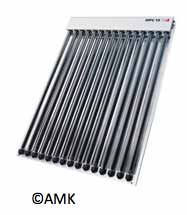
Solar thermal panel
When it comes to the actual collectors that are used, there are two main types:
Evacuated Tubes
Evacuated tube collectors consist of several large glass tubes attached to a manifold box. Each tube has two layers with a vacuum in between to reduce heat loss.
The inner layer is coated with a dark material that absorbs sunlight and directs heat to a central receiver. Generally, these tubes are regarded as being more efficient than flat plate collectors.
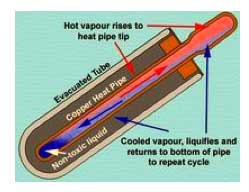
Solar thermal evacuated tube collector
There are two types of evacuated tube collectors:
- Heat Pipe Evacuated Tubes: Each tube contains a copper pipe with a partial vacuum and volatile fluid. When heated by the sun, the fluid vaporises and rises to the manifold box, transferring heat to a carrier fluid that heats your water.
- Direct Flow Evacuated Tubes: These tubes contain a carrier fluid that absorbs heat directly from the tube coating. The heated fluid then flows through the tubes and into your home’s pipe work to heat the water.
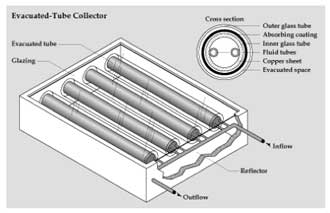
Solar Thermal Direct flow evacuated tube collector
Flat Plate Collectors
Flat plate collectors resemble standard solar panels. They consist of pipes covered by an absorbent material and transparent glazing. The pipes carry a fluid, usually water or a water-antifreeze mix, which transfers heat to your home’s water supply. These collectors can be mounted on top of or integrated with your roof tiles.
Some models feature a drain-back mechanism that drains the fluid when the system is off, preventing boiling or freezing inside the collector.
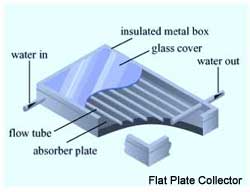
Solar thermal flat plate collector panel
Aside form the 2 main types of collectors, there are 4 main ways in which the system can be used to actually heat your water, these are as follows:
- Direct Systems: Water used in the home is heated directly by the collector.
- Indirect Systems: A substance known as a transfer fluid is heated by the collector, which in turn then heats the water used in the home.
- Active Systems: Electricity is used to power the system and pumps that pump water around it.
- Passive Systems: These systems use the naturally occurring convection to move hot water around the system.
The Solar Cylinder
The solar cylinder is usually 30-50% larger than a standard hot water cylinder. There are two types:
- Vented: This type connects to your existing cold water feed tank, so it needs to be installed nearby.
- Unvented: This type connects directly to your mains cold water supply, allowing installation anywhere in the house. It provides mains pressure hot water without a pump, but requires additional safety checks.
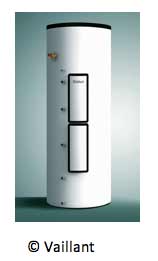
Vaillant Solar Cylinder
Is a Solar Thermal System Suitable for my Home?
Before you go ahead and actually get a solar thermal system installed in your home, it’s very important to actually run through a few points first. Due to the cost of such a system, you really need to figure out if it’s actually worth the investment. Ask yourself the following questions:
- 1. Do you have a suitable location to install a new, fairly large, hot water cylinder?
- 2. Do you have a newish boiler that would be compatible with a solar thermal system?
- 3. Do you have a southern facing roof that catches a lot of sun light all year round?
When it comes to sunlight, this is arguably the most important factor as the entire system relies on the heat captured form the sun. Ideally you would have a south facing roof that gets sun for most of or at least a good part of the day that’s somewhere between a 20 to 50 degree angle of incidence. If not, then other surfaces such as flat roofs or walls can be utilised, as long as they get the required sun exposure.
Additionally, the collectors themselves can be very heavy and you will need to have the installer check your roof to confirm that it will support the panels. If not, it could involve costly work to improve it.
Another significant factor is your boiler – it will need to be compatible with a solar thermal system. If not then you will need to get a new boiler installed, which could potentially run into at least £1500, if not more!
Finally, you will also need a good amount of space to house the water storage cylinder. Typically these are similar to an immersion heater tank, only a fair bit larger!
If the answer to any of these is a resounding no, then getting a solar thermal system installed may not actually be worth it for you.
How Much Water will a Solar Thermal System Actually Heat?
In very general terms, as it will really depend on how efficient the system is and how much water a household uses, a solar thermal system could provide around 50% of the total hot water required by a house, give ro take 10% or so.
Another significant factor here will also be the time of year. Obviously during the height of summer, where the sun is at its strongest it should provide a good proportion of any required heated water.
Whereas during winter months where there will be little sun, it may only produce very little, if any, depending on the collectors location.
Solar Thermal Installation Checklist
Consider the following points when it comes to installation:
- Roof Space: You’ll need around 1m² of collectors per person in your home. The Energy Saving Trust recommends 5m² for the average home. The ideal location is south-facing and sunlit most of the day. A wall or flat roof frame can also be used where this isn’t possible.
- System Compatibility: Most systems are compatible, but if you have a combi boiler without a cylinder, installation may be challenging. Check with your installer for details.
- Space for Solar Cylinder: You may need to replace your current cylinder with a larger solar cylinder (30 to 60 litres). Alternatively, you can add a cylinder with a solar coil or retrofit a solar coil to your existing cylinder if it’s large enough.
- Planning Permission: Generally, planning permission is not required unless collectors exceed 20cm in height when installed.
- Current Heating Fuel: Solar thermal systems offer significant energy savings for solid fuel, electric, or oil-based systems. Gas users may also see savings due to recent energy cost increases.
- Other Building Work: Combining solar installation with other building projects can reduce costs.

Solar thermal panels being installed on roof
Solar Thermal Costs
The Energy Saving Trust estimates that installing a solar thermal system costs between £4,000 and £6,000. More powerful systems are more expensive but can save more on heating bills.
Solar thermal systems are low-maintenance and cheap to run since they use free solar energy.
Systems typically come with a 5 to 10-year guarantee. Opt for an insurance-backed guarantee (IBG) to cover any potential faults or issues, if such an cover is available, it’s well worth it, if only just for the peace of mind.
Check the system annually for proper operation and fluid leaks. Some companies offer annual maintenance services. Professional inspections should be done every 3-7 years. The carrier fluid needs replacement every few years at a cost of around £500.
Installation Time
On the whole, the time it takes to install a solar thermal system will really depend on the size of the system and what existing features can be used.
As a very rough estimate, 2 days can be used as a guide, however if additional extensive works need to be undertaken such as installing a new boiler or radiators or significant pipe re-working needs to be done to install the water storage cylinder, this can be significantly lengthened.
Solar Thermal Installers
For a reliable solar thermal system that meets government Renewable Heat subsidy standards, always choose an MCS accredited installer.
MCS accreditation is only really required if you are enrolling onto the Renewable Heat Incentive scheme, however this scheme has now ended and is no longer accepting applications.
Despite this, you should always go with an installer that is highly reputable, so always as with any home improvement project, always get references and check with past customers!
The Benefits of Solar Thermal Systems
Solar thermal systems utilise free energy to heat water, resulting in ongoing savings after the initial investment.
While historical grants for solar thermal installations have now ceased, those who enrolled earlier still benefit from ongoing payments.
Despite initial costs, installing a solar thermal system can lead to significant long-term savings, particularly in today’s high energy cost environment.
- Reduce carbon emissions: Solar thermal systems can reduce your home’s carbon footprint by up to 510kg annually by reducing fuel consumption for water heating.
- Low maintenance costs: Once installed, maintenance expenses are minimal, providing cost-effective hot water.
- Year-round hot water: Solar thermal systems continue to heat water throughout the year, complementing your boiler in winter months.
Solar Thermal – Maximising Your Savings
To maximise your savings with a solar thermal system, consider these tips:
- Use solar heated water whenever possible: Install a mixer shower instead of an electric one, and place ‘hot fill’ appliances close to the solar cylinder.
- Optimise your boiler’s timing: Adjust your boiler’s timer so it operates only when the solar thermal system requires topping up.
If you are looking to save money on your heating and hot water costs and also help the environment by reducing your carbon footprint, then installing a solar thermal system is a great way to do this, providing that you meet the installation requirements that we have set out above.

